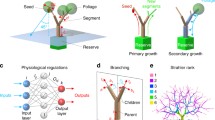Abstract
Trees architectural study shows gradients in the meristematic activity. This activity is described by the number of internodes per growth unit, which is considered as the output of a dynamic random process. Several species were observed, which led us to propose and then estimate some mathematical models. Computing the functioning of a tree in a given environment therefore involves finding the probability function of the meristems and following the evolution of the parameters of this law along the botanical gradients (order, trend, acrotony) within its architecture.
Similar content being viewed by others
References
Assaf, R. (1965). Etude sur la croissance des rameaux de diverses espèces fruitières. Thèse de doctorat. Université de Toulouse. 104p.
Chavaneau, C. (1989). Modélisation de la croissance et de l'architecture de l'Abricotier. D.A.A., spécialité: Agronomie méditerranéenne. Montpellier, ENSA. 77p.
Costes, E. (1988). Analyse architecturale et modélisation du Litchi (litchi chinensis Sonn.). Contribution à l'étude de son irrégularité de production l'Ile de la Réunion. Thèse de doctorat. Université de Montpellier. 210 p.
Costes, E. (to appear). Modélisation de l'architecture de l'Hévéa. Convention IRCA/CIRAD. Rapport de mission.
Crabbé, J. (1987). Aspects particuliers de la morphogénèse caulinaire des végétaux ligneux et introduction à leur étude quantitative. IRSIA, Presses Univ. de Bruxelles. 116 p.
De Reffye, Ph. (1979). Modélisation de l'architecture des arbres par des processus stochastiques. Simulation spatiale des modèles tropicaux sous l'effet de la pesanteur. Application au coffea robusta. Thèse de doctorat d'Etat. Université de Paris-Sud Orsay. 194 p.
Édelin, C. (1977). L'architecture monopodiale: exemple de quelques arbres d'Asie tropicale. Thèse de doctorat d'Etat. Université de Montpellier. 285 p.
Fournier, D. (1989). Modélisation de la croissance et de l'architecture du Merisier (prunus avium L.). D.A.A., spcialité: Agronomic mditerranéenne. Montpellier, ENSA. 77 p.
Hallé, F. and R. Martin (1968). Etude de la croissance rythmique chez l'Hévéa (hevea brasiliensis Müll-Arg. Euphorbiaces-Crotonoides). Adansonia Ser., 2(8): 475–503.
Hallé, F., R.A.A. Oldeman and P.B. Tomlinson (1978). Tropical trees and forests. An architectural analysis. Berlin, Springer Verlag. 441 p.
Rivals, P. (1965). Essai sur la croissance des arbres et sur leurs systèmes de floraison. Journal d'Agriculture Tropicale et de Botanique Appliques, XII: 655–686
Rey, H. and Y. Caraglio (to appear). Analyse architecturale et modelisation du Peuplier. Convention IDF.
Author information
Authors and Affiliations
Rights and permissions
About this article
Cite this article
de Reffye, P., Elguero, E. & Costes, E. Growth units construction in trees: A stochastic approach. Acta Biotheor 39, 325–342 (1991). https://doi.org/10.1007/BF00114185
Published:
Issue Date:
DOI: https://doi.org/10.1007/BF00114185




